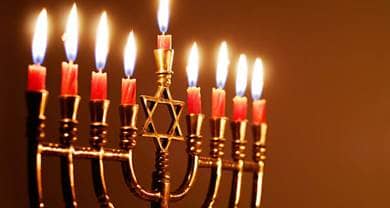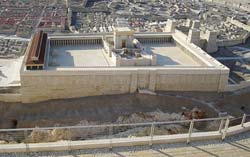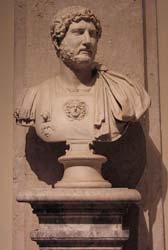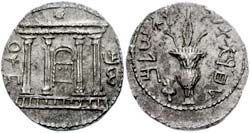- Trending:
- Forgiveness
- |
- Resurrection
- |
- Joy
- |
- Feminism
- |
- Afterlife

RELIGION LIBRARY
Judaism
Early Developments
 In the waning days of the Judean "Great Revolt" against the Romans in 70 C.E., Rabban Yohanan ben Zakkai, who had supported the war until it was too late, was imprisoned in the northern town of Yavneh in a type of internment camp. Yet rather than retreating into quietistic study, Rabban Yochanan reconvened the Sanhedrin of the Second Temple period, a legislative court that was recognized by the Romans as the rabbinic seat of self-government for the consular province of Judea. (This was known as the synod of Yavneh.) Demonstrating an ironically symbiotic relationship, the Roman authorities needed the rabbis to run the internal affairs of the Judean population, while the rabbis depended upon Roman support to consolidate their authority.
In the waning days of the Judean "Great Revolt" against the Romans in 70 C.E., Rabban Yohanan ben Zakkai, who had supported the war until it was too late, was imprisoned in the northern town of Yavneh in a type of internment camp. Yet rather than retreating into quietistic study, Rabban Yochanan reconvened the Sanhedrin of the Second Temple period, a legislative court that was recognized by the Romans as the rabbinic seat of self-government for the consular province of Judea. (This was known as the synod of Yavneh.) Demonstrating an ironically symbiotic relationship, the Roman authorities needed the rabbis to run the internal affairs of the Judean population, while the rabbis depended upon Roman support to consolidate their authority.
 The strength of this relationship was tested just two generations after the Great Revolt during the "Bar Kochba Revolt" from 132-135. It was led by someone whom many in the rabbinic community perceived to be a messianic figure orchestrating an epic battle against the Roman forces of Emperor Hadrian. Yet this was not just a messianic movement of mass hysteria. Leases of re-conquered land and coins with Bar Kochba's name inscribed on them followed by the words "Prince of Israel" have been discovered in the Judean desert near Ein Gedi, and one of the greatest rabbis of his generation, Rabbi Akiba, publically recognized him as the Messiah. Hence it is clear that the rabbis were anything but pacifistic spiritualists as earlier scholars of Jewish history have surmised.
The strength of this relationship was tested just two generations after the Great Revolt during the "Bar Kochba Revolt" from 132-135. It was led by someone whom many in the rabbinic community perceived to be a messianic figure orchestrating an epic battle against the Roman forces of Emperor Hadrian. Yet this was not just a messianic movement of mass hysteria. Leases of re-conquered land and coins with Bar Kochba's name inscribed on them followed by the words "Prince of Israel" have been discovered in the Judean desert near Ein Gedi, and one of the greatest rabbis of his generation, Rabbi Akiba, publically recognized him as the Messiah. Hence it is clear that the rabbis were anything but pacifistic spiritualists as earlier scholars of Jewish history have surmised.
 Yet after suffering heavy casualties along with the Romans, the majority of rabbis realized that while it was important to maintain a strong sense of nationalism, they needed to develop a more accommodating position toward Rome in order to maintain their internal autonomy. In order to accomplish this, the rabbis first had to cement their hold on power within the Jewish community by linking themselves to their Israelite past and their messianic future.
Yet after suffering heavy casualties along with the Romans, the majority of rabbis realized that while it was important to maintain a strong sense of nationalism, they needed to develop a more accommodating position toward Rome in order to maintain their internal autonomy. In order to accomplish this, the rabbis first had to cement their hold on power within the Jewish community by linking themselves to their Israelite past and their messianic future.
By the end of the 2nd century, perhaps in response to Church Father Irenaeus's notion of apostolic succession, the rabbis proclaimed a chain of authority that they attributed to the earlier synod of Yavneh. Both the early Christian and rabbinic cultures were constructing parallel frameworks of leadership based on the shared Hellenistic idea of diadoche, a record of succession linking established teachers with a larger school of thought, while tracing their lineage back to its founder. In the mishnaic text, Pirkei Avot, "Ethics of the Fathers," the rabbis constructed a chain of oral tradition beginning with the revelation at Mt. Sinai to Moses, who passed it on to Joshua, who handed it down to the Elders, who transmitted it to the Prophets and finally to the men of the Great Assembly. These Palestinian rabbis claimed that the process of rabbinic ordination had already begun with Moses, whom they referred to as Moshe Rabbeinu, "our rabbi." Based on their exclusive claim to the Oral Law transmitted from God to Moses and passed down through the chain of tradition, the rabbis were able to permanently legitimize their political and religious power.
 Once they established their grounding in the Oral Torah, the rabbis debated about how to craft a messianic doctrine that would give them the theological and political authority to lead their people forward. On the one hand, in chapter 11 of the Talmudic tractate Sanhedrin, there were various rabbinic predictions of when the Messiah would come in their generation that were consistent with the miraculous messianic speculation of the Second Temple period. On the other hand, in light of the messianic foundation for the "Great Revolt," the early Jewish-Christian messianism articulated in the Christian Gospels, and the failed messianic revolt of Bar Kochba, the rabbis formulated a substantial number of anti-messianic statements in the very same Talmudic tractate. These completely suppressed the human role in achieving redemption while leaving it wholly in the hands of God.
Once they established their grounding in the Oral Torah, the rabbis debated about how to craft a messianic doctrine that would give them the theological and political authority to lead their people forward. On the one hand, in chapter 11 of the Talmudic tractate Sanhedrin, there were various rabbinic predictions of when the Messiah would come in their generation that were consistent with the miraculous messianic speculation of the Second Temple period. On the other hand, in light of the messianic foundation for the "Great Revolt," the early Jewish-Christian messianism articulated in the Christian Gospels, and the failed messianic revolt of Bar Kochba, the rabbis formulated a substantial number of anti-messianic statements in the very same Talmudic tractate. These completely suppressed the human role in achieving redemption while leaving it wholly in the hands of God.
| The Three Oaths |
|
|
In fact, Jewish historians argue that post-Bar Kochba rabbis were actually responsible for attributing anti-messianic, pacifistic statements to the 1st-century Rabban Yochanan in order to justify their position. These later rabbis ultimately articulated the radical anti-messianic doctrine of the "three oaths," based on a midrash or interpretation of a thrice-repeated statement from the biblical book, Song of Songs 2:7, "Do not rouse love until it pleases." The rabbis interpreted this to refer to three oaths made between God, Israel, and the nations in which God made the Jews swear not to force the coming of the Messiah or collectively immigrate to the land of Israel in exchange for the nations' promise that they would not oppress the Jews "too much." This amounted to a Jewish doctrine of political passivity in exchange for foreign toleration.
| Presumed line of descendants |
| Biblical king David Rabbinic leaders of 2nd and 3rd centuries |
Yet in response to the extreme views of apocalyptic and passive messianism, a group of rabbis articulated what had been referred to as "realistic messianism," a doctrine that channeled the revolutionary aspects of messianism into a mainstream political and religious movement to restore Jewish sovereignty. This view was implied by the 3rd-century Rabbi Samuel who argued that the only difference between the present and the messianic future is that Jews will no longer be controlled by foreign political powers. In fact, the rabbinic leaders of the Babylonian and Palestinian communities in the late 2nd and 3rd centuries were perceived as messianic figures based on their lineages in the royal line of King David, whose descendant would be the Messiah or "anointed" King who would usher in the third Jewish commonwealth. Moreover, the Babylonian leader or Exilarch acted like a substitute monarch possessing a royal court that actually became a source of controversy to other rabbinic leaders who also made claims to the Davidic lineage. Regardless, the prevailing view in the rabbinic community was that the rabbis were the precursors to the messianic era who would create the political infrastructure necessary for the Messiah to reestablish the Davidic kingdom and govern according to the laws of the Torah.
Study Questions:
1. Is it appropriate to think of Judaism's early rabbis as pacifistic spiritualists? Why?
2. How was power legitimated among early rabbis?
3. What was the “realistic messianism,” and what was its purpose?










